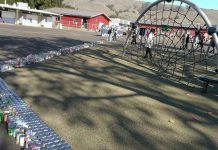A $498,000 federal grant to change the education focus at Live
Oak High School is running into opposition from some teachers. The
latest controversy in the Morgan Hill School District is dissension
over the grant to implement small learning communities, sometimes
called clusters, at the high school level.
A $498,000 federal grant to change the education focus at Live Oak High School is running into opposition from some teachers.
The latest controversy in the Morgan Hill School District is dissension over the grant to implement small learning communities, sometimes called clusters, at the high school level.
Live Oak High teacher and head football coach Glen Webb blasted the 79-page grant application and district administration in a talk Monday night to district trustees.
“The Small Learning Communities grant is an incredible document that has been soft sold to the teaching staff while misrepresenting the truth to the federal government,” he said. “It is an example of our administration’s lack of respect for genuine teacher input and a complete show of dishonesty and arrogance from the leaders that have always claimed to not have a ‘hidden agenda.’”
The history of the grant is disputed. Some teachers have said they had no opportunity to contribute to discussions about the grant. Other teachers have said they remembered staff discussions about the small learning communities (SLCs), but thought that no decision had been made.
Trustees on Oct. 6 accepted the grant on a 4-3, with Tom Kinoshita, George Panos, Del Foster and Jan Masuda in favor. Opposed were Mike Hickey, Amina Khemici and Shellé Foster.
Live Oak Principal Nancy Serigstad told trustees that night the high school staff is “already behind” in implementing the plan outlined in the grant. When asked specifically what the impact would be of the board’s delaying its decision until the next meeting on Oct. 20, she hesitated, saying she personally wanted to see a decision made, but she stopped short of saying an additional two-week delay would be a real problem.
Thomas said she had requested a copy of the 79-page grant from the District Office the prior Thursday, hoping she would be able to pick it up on Friday and read it over the weekend to be prepared for Monday’s meeting. It was not part of the regular agenda packet.
Trustees received copies of the grant at 5 p.m. Monday, just as they were going into closed session, she said.
Thomas expressed her support for Serigstad and the high school staff, but said she must honor her commitment to voters, which was to read documents before voting on issues. As she was in the middle of a discussion with Serigstad regarding the impact of delaying the vote, Kinoshita called for a vote at the Oct. 6 meeting
Thomas voted against accepting the grant, saying she did so because she felt pushed into it.
The idea of the SLCs themselves is controversial. Hickey said he is against it in principle.
Some parents have voiced fears that clustering means the removal of advanced classes and the “dumbing down” of students instead of offering challenges to rise up to.
“Absolutely not,” Serigstad said. “Students who sign up for AP (advanced placement) courses, students who sign up for an advanced curriculum, that’s a group of students that needs support as much as any of the others. That’s just as much a population at risk as any other. They need to be challenged, they need our support.”
Live Oak currently has several clusters including the computer business academy, the high-tech agricultural science group, the English language learners and special education.
Serigstad said small learning communities “are consistent with the direction outline in Live Oak High’s School Level Plan and the Western Association of Schools and Colleges (WASC) Accreditation Report.”
The grant will allow Live Oak teachers be paid for release time for training on SLCs and to expand the SLCs to include all students at all grade levels, she said.
“The focus for the first year is looking at ninth and tenth grade,” she said, referring to the projected opening of Sobrato High School in August 2004 which will allow district ninth graders to move into the high schools. “As we set curriculum for next year, which we are already moving on, then we can take into account the SLCs.”
Webb said that the way the grant was presented to the staff and to parents is not the way the plan for clusters was presented in the grant.
“The methods by which the staff and community have been maneuvered into this controversial and experimental plan have been extremely dishonest and have indeed relied on blatant lies,” Webb said.
Webb then read from page eight of the grant application.
“Morgan Hill passed a school bond in 1999 to build a second comprehensive high school in the district after stakeholders led conversations among the community about the need to create smaller learning environments. The architectural design for the new high school intentionally supports SLCs as have the plans for the remodeling of Live Oak. Both sets of plans were approved with input from all stakeholder groups including Live Oak teachers, parents and administrators, after explicit discussions regarding the desirability of supporting clusters of students and teachers within the school.”
This statement, Webb said Monday night, makes it seem as if the decision was made in 1999 and that the district gave a different reason to the public for the bond.
“This blatant lie says nothing about the threats of double session, impending development of Coyote Valley, or the desire to move the ninth grade to the high school – these clearly documented issues were central to passing the school bond,” he said. “Have either our community’s voters been intentionally defrauded regarding the need and purpose of the school bond, or has the federal government been defrauded to secure grant dollars?”
In light of the dissension among the staff, Serigstad said she held a staff meeting Monday afternoon to discuss the grant and possibly take a vote on the plan. She said it was important to her and to the success of the plan that there be sufficient staff “buy-in,” and if she didn’t feel it was there, she would recommend trustees reconsider their decision.
No vote took place during the staff meeting Monday, but Serigstad later called the meeting “very productive.” The staff will take a vote on Nov. 17, she said Thursday.
Several teachers said they didn’t share her view, because there was no vote and they had been led to believe there would be a vote during the meeting, but said they were in general supportive of Serigstad.
Other teachers voiced the opinion that the union should have been brought into discussions about the SLCs in the beginning because of the possible change in working conditions, such as block scheduling and having teachers act as counselor-mentors.
In order to clear up confusion about the development of the grant, Serigstad said, she presented a timeline of the grant. According to her timeline, on March 7, high school staff received ballots to vote on seeking funding for SLCs. At the deadline for voting of March 11, the vote was 48 to 8 in favor of seeking funding, or 85.7 percent to 14.3 percent.
The following day, March 12, according to the timeline, results of the vote to move forward with the grant were announced during a department chair meeting, and ideas and suggestions were discussed. On April 2, voluntary prep period meetings to discuss the grant were held in the library conference room, according to the timeline, and two days later, on April 4, staff received a four-page summary of comments and recommendations from the meetings. During the April 7 staff meeting, the grant was discussed.
According to the timeline, after that meeting there were two department chair meetings and one staff meeting where the SLC grant was discussed before Serigstad presented and overview of the grant to the School Board on May 5. She said a copy of the grant application was available at the District Office from that point on.







